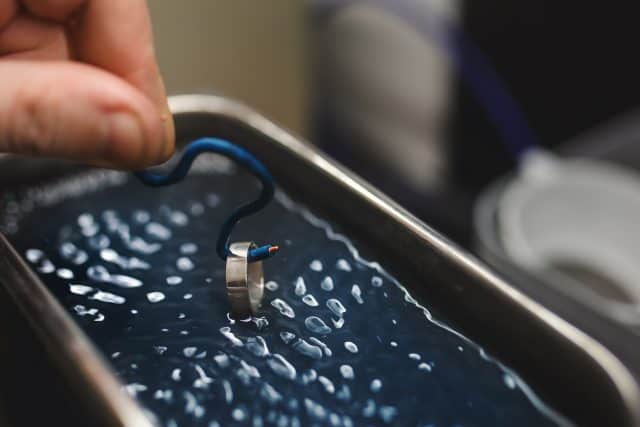How does an ultrasonic cleaner work?
Our ultrasonic cleaning units work by sending high-frequency sound waves through a transducer (a tank of liquid) to remove dirt, grime, and other contaminants. Ultrasonic cleaners convert the high energy of sound waves into an intense but non-invasive cleaning action.
This cleansing process is called cavitation, which is when sound waves cause tiny bubbles to form and rapidly implode, giving off bursts of energy. The high amount of energy then causes displacement of the contaminants in even the most stubborn, tight, and intricate surfaces, without causing any damage to the components being decontaminated.
Instead of using harsh chemicals, our machines clean components with a fluid, ranging from a water-based solution to a special non-harsh chemical solution designed to aid cleaning. This fluid is specially selected to suit both the material of the component being sterilised, as well as the specific type of contamination that needs to be eliminated.
What is the process?
Ultrasonic cleaning works through high-frequency sound waves transmitted through a liquid to clean the surface of parts that are submerged within it. The high-frequency sound waves, typically around 40 Hz, agitate the liquid solution of water or solvent and cause the cavitation process to begin.
The bubbles form when sonic energy from the high-frequency sound waves create a cavity, which gets trapped as a bubble in the liquid solution of the ultrasonic machine. These bubbles then implode with enough force that the surface contaminants are dislodged.
The process of ultrasonic cleaning:
- The part you would like cleaned is placed into the tank of the ultrasonic cleaning machine.
- The tank is then filled with enough liquid (water/cleaning solution) to submerge the part.
- The tank is then closed, and the ultrasonic machine is activated.
- Inside the machine, the transducers and ultrasonic wave generators cause the tank to vibrate and produce cavitation. The pressure from this process forces dirt, rust, and other contaminants to loosen from the part.
- Five minutes later, the tank’s contents are clean and ready to be used again.
The dissolution of a contaminant
To dissolve a soluble contaminant from a part, it must be in constant contact with the cleaning agent. However, over time, it is likely the cleaning agent will weaken in strength, potentially forming a saturated layer that may serve as a barrier between the contaminant and the cleaning agent.
The ultrasonic implosions are particularly effective at displacing the saturated layer, thus allowing fresh cleaning agents to reach the contaminant.
In this way, ultrasonic cleaning is a catalyst capable of speeding up the dissolution process, and is especially advantageous when cleaning irregular surfaces or component internals.
The displacement of a contaminant
In the case of insoluble contaminants, it is essential that the cohesive forces formed between the contaminant and the component are broken down sufficiently, to allow the contaminant to be removed.
In ultrasonic cleaning, the strong force generated from ultrasonic implosions displaces and removes insoluble contaminants. The minuscule scale of the cavitation bubbles ensures that they can clean hard-to-reach areas such as hinges, screw threads, and valves.

What industries is ultrasonic cleaning used in?
Regardless of the industry you work in, we can provide you with an ultrasonic cleaning system that will leave your components precision cleaned within an average time of ten minutes.
Our ultrasonic cleaning systems are perfect for use in many industries, including energy, aerospace, and electronics. It is particularly good for the pharmaceutical and medical sectors too, because our machines are perfect for cleaning precision instruments. This is because the process is safe and effective as no harsh chemicals are used.
The wide range of industries in which ultrasonic cleaners can be used includes:
- Manufacturing
- Automotive
- 3D Printing
- Electronics
- Machined Parts
- Recondition & Servicing
- Aerospace
- Medical & Pharma
- Food & Beverage
How we can help
Our tanks are perfect for ultrasonic cleaning in industrial settings. All our machines are strong, robust, and reliable as they are made from fabricated 316L stainless steel, meaning the tanks are robust and long-lasting.
Whether you are searching for a single unit, a large standalone unit, or a multi-stage plant unit, we have the industrial cleansing unit to match your needs. We have a wide range of cleaning machines available for sale, from small 9-litre cleaning units to larger 200-litre industrial units and multi-stage cleaners. Our units can also be custom-built to whatever size you require, and we can add optional extras such as filtration, oil skimmers, and custom-made baskets.
Want to purchase an ultrasonic cleaning unit?
We have over 40 years of experience, and over the years we have built a great culture of service, teamwork and innovation. Our cleaning systems are like no other – they are environmentally friendly, efficient, and very effective for cleaning a wide range of components. Our machines are safe and are a very effective alternative to using harsh chemicals which could damage your equipment.
Contact us today, so we can provide you with a life-changing machine that will make the cleaning process of your business’s components quicker and more efficient.


